Memory Frequency Scaling on Intel's Skull Canyon NUC - An Investigation
by Ganesh T S on August 29, 2016 8:00 AM ESTPremium DRAM Options for the Skull Canyon NUC
There are plenty of DDR4 SODIMM kits that are compatible with the Intel Skull Canyon NUC (NUC6i7KYK). However, it is likely that people interested in memory overclocking are likely to go for the premium options in terms of speed as well as capacity. In addition to the frequency, the timing parameters / latency numbers also influence the performance. For our evaluation today, we are going to look at five different options (presented below in alphabetical order of the vendors):
- Corsair Vengeance DDR4 SODIMM 2x16GB @ 2666 MHz, 18-19-19-39
- Crucial Ballistix Sport LT DDR4 SODIMM 2x16GB @ 2400 MHz, 16-16-16-39
- G.Skill Ripjaws DDR4 SODIMM 2x16GB @ 3000 MHz, 16-18-18-43
- Kingston HyperX Impact DDR4 SODIMM 2x16GB @ 2400 MHz, 14-14-14-35
- Patriot Viper Series DDR4 SODIMM 2x16GB @ 2800 MHz, 18-18-18-43
Out of these kits, the G.Skill Ripjaws and the Kingston HyperX Impact stand out. The former for being the kit with the maximum rated operating frequency and the latter for having the lowest latency numbers of all the tested kits.
Corsair Vengeance [ 2666 MHz, 18-19-19-39 ]
The Corsair Vengeance memory kit used in our review supports XMP, and no special configuration is needed to take advantage of the higher performance timings. FinalWire's AIDA64 can do extensive parsing of the SPD information and present the results in an easy-to-understand manner. Our review kit contained memory sourced from Samsung.
CPU-Z shows the operating parameters of the SODIMMs as seen by the OS. AIDA64 also has a quick cache and memory benchmark that provides some basic bandwidth and latency numbers to ensure that the kits are operating as expected.
Crucial Ballistix Sport LT [ 2400 MHz, 16-16-16-39 ]
The Crucial Ballistix Sport LT memory kit also supports XMP, and was able to run at 2400 MHz right out of the box. Given that Crucial is Micron's brand, it is no surprise that the memory in the kit is sourced from Micron's fabs.
The relevant CPU-Z and AIDA64 memory benchmark screenshots are provided below.
G.Skill Ripjaws [ 3000 MHz, 16-18-18-43 ]
The G.Skill Ripjaws memory kit used in this study turns out to be an excellent candidate in terms of specifications. Not only does it operate at higher frequencies compared to all other kits in the review, it also has better latency numbers compared to the Corsair and Patriot kits which operate at lower frequencies. AIDA64 shows that the kit also supports two XMP profiles for the highest operating frequency (DDR4-3000), one at 16-18-18-43 and another at 18-18-18-43. The memory is sourced from Samsung.
Upon booting into the BIOS after installation, I found that the memory was only configured to run at 2667 MHz. Altering the 'Automatic' DRAM timings to 'Manual' and 'user-defining' the various timing parameters as printed on the SODIMM label (16-18-18-43) enabled higher frequency operation. I ran Memtest86 overnight to ensure that the NUC6i7KYK was stable with the manually input parameters before proceeding with the rest of the benchmarks.
Kingston HyperX Impact [ 2400 MHz, 14-14-14-35 ]
The Kingston HyperX Impact kit stands out for its low latency numbers / timing parameters. It also supports XMP, and the NUC6i7KYK booted with the kit operating at 2400 MHz right away. AIDA64 shows that the memory is sourced from SK Hynix's fabs.
The relevant CPU-Z and AIDA64 memory benchmark screenshots are provided below.
Patriot Viper Series [ 2800 MHz, 18-18-18-43 ]
The Patriot Viper series of DDR4 SODIMMs also supports XMP, and the kit worked at 2800 MHz right out of the box in the NUC6i7KYK. Even though the SPD information is incomplete, we confirmed from Patriot that the Viper series uses memory from Samsung's fabs.
The CPU-Z and AIDA64 benchmark numbers are reproduced below.


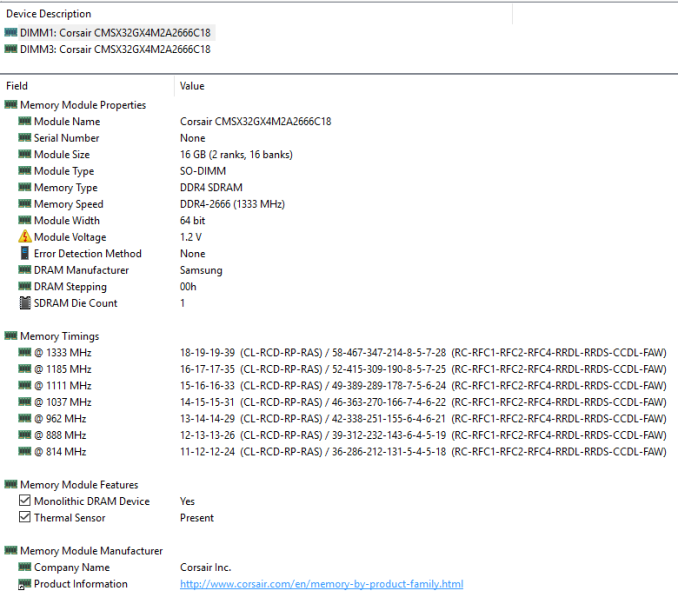
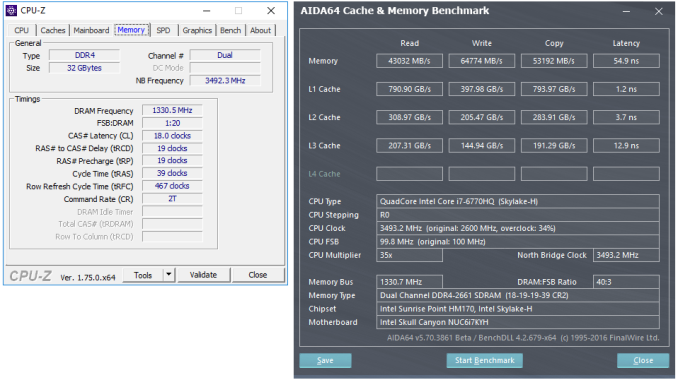


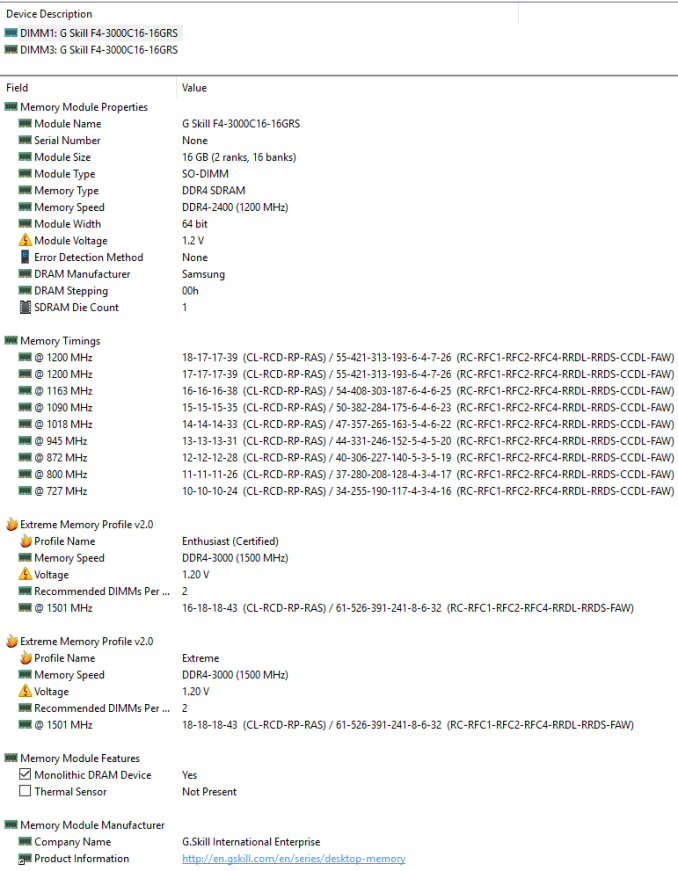
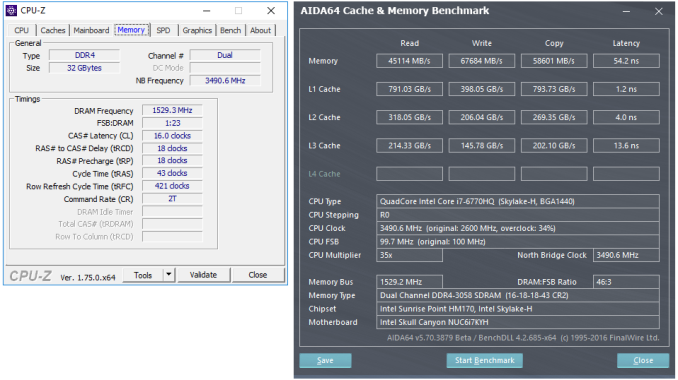
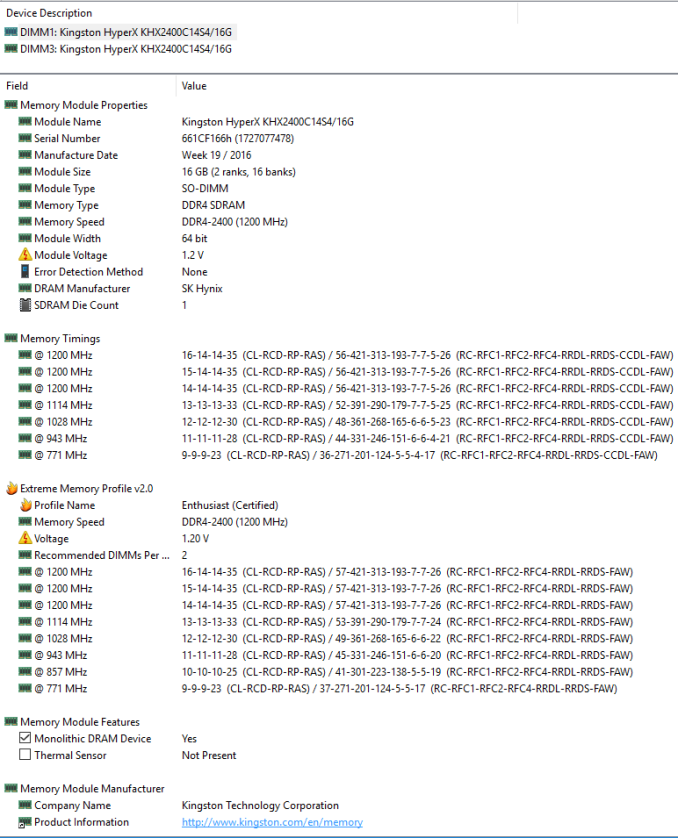
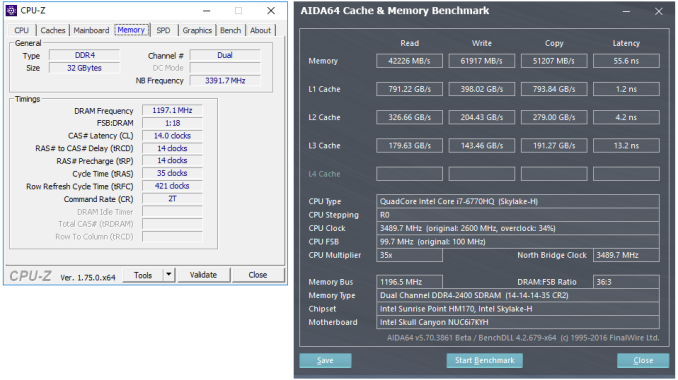
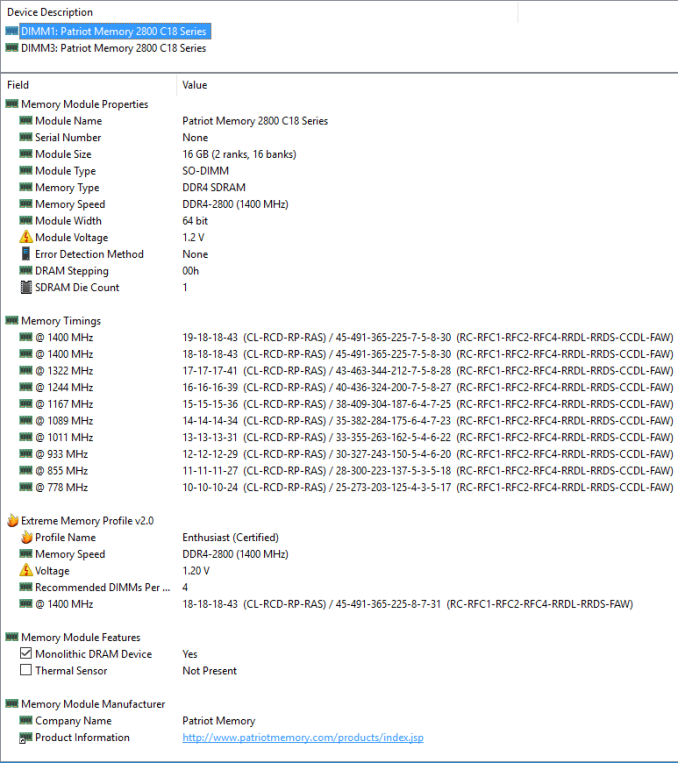
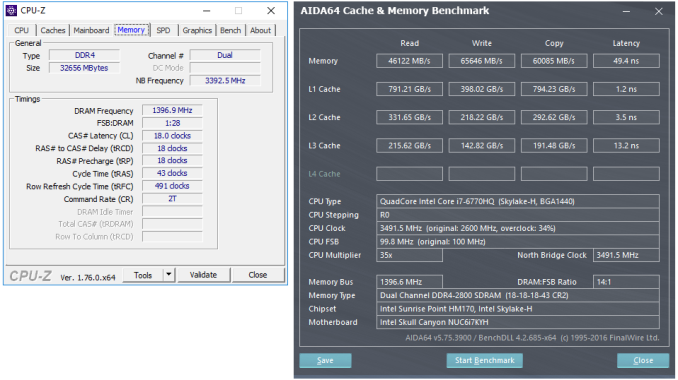








31 Comments
View All Comments
zodiacfml - Monday, August 29, 2016 - link
AMD APUs please.tipoo - Monday, August 29, 2016 - link
Neat test. Interesting that the Iris Pro barely sees any scaling with memory bandwidth, indicating to me that the eDRAM really does cover its bandwidth needs nicely.I feel like the SC NUC could have been more with another inch of cooling height though. The GPU drops back to its base clocks quickly, having so many more EUs than the Iris Pro 5200 should have brought more gains than we saw since it's not bandwidth bound.
mcmillanit - Monday, August 29, 2016 - link
I have a SC.I attached an nvidia gtx 750ti using the bplus v4.1 egpu adapter.
When version 2 of the thunderbolt adapters become available, I will probably switch to one of those, but for now, m.2 to pcie adapter is ugly, but works, and works well. It is only using pcie1 x4, but that is sufficient.
The user experience is vastly improved. The video is smooth, and without the thermal load of the GPU on the processor, the cpu stays much cooler while it maintains higher clock speeds when I game or watch youtube.
-Michael
powerarmour - Monday, August 29, 2016 - link
How about investigating where all the GPU reviews have gone?Ranger1065 - Tuesday, August 30, 2016 - link
Anandtech is so BROKEN....Ian Cutress - Tuesday, August 30, 2016 - link
We've hit every major CPU launch on day one with every CPU available at launch being tested for the last two years - over and above any other website coverage. So wait, broken?JackNSally - Wednesday, August 31, 2016 - link
CPU=/=GPUzaza - Monday, August 29, 2016 - link
intersting results. can you redo the test but using normal CPU socket. The eDRAM might have played a role keeping the bandwidth and latency in check, but to be sure we have to test the effect on normal socket. and is it possible to test also with DDR3? since some skylake motherboards do support DDR3 memeoryIan Cutress - Monday, August 29, 2016 - link
You mean what we posted last august? DDR4 vs DDR3L ?http://www.anandtech.com/show/9483/intel-skylake-r...
ganeshts - Monday, August 29, 2016 - link
(1) Skull Canyon uses BGA, so it is not possible to move to a non-eDRAM processor on this testbed.(2) As I have explained in the article, the only platform we could source that supports memory OC AND supports SODIMMs was the Skull Canyon NUC. Our focus was on the large number of OC-ed DDR4 SODIMMs that have come to the market in the last few months.
(3) Practical comparisons of DDR3 vs. DDR4 with real-life workloads is quite difficult because, in a real system, the boards would be completely different in terms of system configuration and there are too many factors involved that it wouldn't be possible to do an apples-to-apples comparison.